Bald tyres are often seen as a mere inconvenience, but they can have serious implications for your vehicle’s fuel efficiency. Did you know that driving on bald tyres not only poses safety risks but can also lead to increased fuel consumption?
This article will delve into how bald tyres affect fuel economy, the mechanics behind it, and why maintaining adequate tread depth is crucial for both safety and savings.
Contents
Key Takeaways
- Increased Rolling Resistance: Bald tyres create more friction on the road, forcing the engine to work harder and leading to higher fuel consumption.
- Reduced Grip and Handling: With less tread, bald tyres compromise traction, which can negatively impact vehicle control and efficiency.
- Safety Risks: Driving with bald tyres increases the risk of accidents due to longer stopping distances and reduced grip, making timely replacement essential.
- Cost Implications: The financial burden of increased fuel costs from bald tyres can add up over time, making regular tyre maintenance a smart investment.
- Legal Requirements: Many regions have legal minimum tread depth regulations; driving on bald tyres can lead to fines and penalties.
The Impact of Bald Tyres on Fuel Efficiency
Bald tyres are defined as having little to no tread left, typically below the legal limit of 1.6mm in many places. When tyres lose their tread, they lose their ability to grip the road effectively.
This lack of grip leads to increased rolling resistance—the force that opposes the motion of the vehicle. As a result, the engine has to exert more power to maintain speed, which directly translates into higher fuel consumption.
How Tread Depth Affects Performance
New tyres generally have a tread depth of around 8mm or more, which helps channel water away and provides better traction. As the tread wears down, especially when it reaches a bald state, the tyre’s performance diminishes significantly.
Studies indicate that vehicles with worn or bald tyres can experience a noticeable increase in fuel usage due to this higher rolling resistance and decreased efficiency in handling.
Safety Concerns with Bald Tyres
Driving on bald tyres is not just about fuel efficiency; it’s also a significant safety hazard. The lack of tread increases the likelihood of aquaplaning in wet conditions, leading to loss of control.
Additionally, bald tyres require longer distances to stop effectively. This combination of factors makes driving on them incredibly risky.
Legal Implications
In many jurisdictions, it is illegal to drive with tyres that have insufficient tread depth. Authorities enforce these laws not only for safety reasons but also because worn-out tyres can lead to accidents that endanger other road users. Being pulled over for bald tyres can result in fines and demerit points.
Real-World Examples
Consider a fleet of delivery vehicles operating with a mix of well-maintained and bald tyres. The vehicles with bald tyres would likely incur higher fuel costs due to increased consumption from poor traction and handling.
Conversely, those with adequate tread would perform better, resulting in lower operational costs over time.
Practical Applications
For drivers looking to save money on fuel and enhance safety, regularly checking tyre tread depth is essential. It’s advisable to replace tyres once they reach around 3mm of tread depth rather than waiting until they become completely bald.
This proactive approach not only improves fuel efficiency but also ensures better handling and safety on the road.
Conclusion
In summary, bald tyres significantly affect fuel consumption by increasing rolling resistance and compromising vehicle handling. The safety risks associated with driving on worn-out tyres further highlight the importance of regular maintenance.
By ensuring your tyres are always in good condition, you can save money at the pump while also prioritizing your safety and compliance with legal standards. Don’t wait—check your tyre tread today!
Citations:
[1] https://www.jaxtyres.com.au/knowledge/tyres/bald-tyres
[2] https://overton-automotive.co.uk/blogs/how-your-vehicles-tyres-could-be-wasting-you-fuel/
[3] https://napacarcare.com/auto-repair-tips/how-your-vehicles-wheel-alignment-affects-fuel-economy/
[4] https://www.goodyearautocare.com.au/commercial/truck-tyres/fuel-efficiency/
[5] https://gprtrucks.com.au/how-wheel-alignment-helps-fuel-efficiency/
[6] https://collinsvilleauto.com/can-misaligned-wheels-affect-your-vehicles-fuel-efficiency/
[7] https://www.firestonecompleteautocare.com/blog/alignment/benefits-of-wheel-alignment/
[8] https://www.gat-matic.com/can-improper-alignment-affect-my-fuel-efficiency/

Hi, I’m Sufiyan, the developer behind this platform. I created FuelConsumptionCalculator.com to simplify fuel tracking for everyone — because understanding your vehicle shouldn’t require a degree in mechanics. I’m always working on adding more tools and content to make this site even more useful

